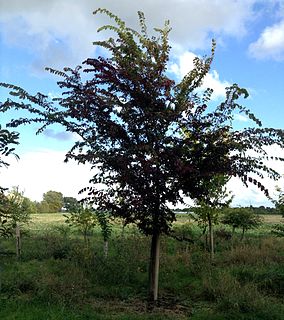
Ulmus 'Frontier' is an American hybrid cultivar, a United States National Arboretum introduction derived from a crossing of the European Field Elm Ulmus minor with the Chinese Elm Ulmus parvifolia in 1971. Released in 1990, the tree is a rare example of the hybridization of spring- and autumn-flowering elms. Tested in the US National Elm Trial coordinated by Colorado State University, 'Frontier' averaged a survival rate of 74% after 10 years.

The Wych Elm cultivar Ulmus glabra 'Lutescens', commonly known as the Golden Wych Elm, arose as a sport of a wych found in the York area in the early 19th century by W. Pontey of Pontey's nursery, Kirkheaton, Huddersfield, who propagated and distributed it. The original tree he named the Gallows Elm for its proximity to a gallows near York. Loudon in The Gardener's Magazine (1839) identified it as a form of Ulmus montana, adding 'Lutescens' by analogy with Corstorphine sycamore, Acer pseudoplatanus 'Lutescens'.
The Chinese Elm cultivar Ulmus parvifolia 'UPMTF' was raised by Moon's Tree Farm nursery, Atlanta, United States.
The Chinese Elm cultivar Ulmus parvifolia 'Burgundy' is a small American development.

The Chinese Elm cultivar Ulmus parvifolia 'Emer II' or 'Emerald Vase' was cloned from a tree planted circa 1910 on the University of Georgia campus at Athens.
The Chinese Elm cultivar Ulmus parvifolia 'Emer I' or 'Emerald Isle' was cloned from a tree planted circa 1920 on the University of Georgia campus at Athens.

The Chinese Elm cultivar Ulmus parvifolia 'Drake' was marketed by the Monrovia Nursery of Azusa, California from 1952–53.
The Chinese Elm cultivar Ulmus parvifolia 'Dynasty' is a United States National Arboretum introduction reputed to be very fast-growing.
The Chinese Elm cultivar Ulmus parvifolia 'Hallelujah' is one of three American introductions made circa 1992 that were selected for their cold hardiness. 'Hallelujah' is known to have withstood -37°C (-35°F) in Missouri.
The Chinese Elm cultivar Ulmus parvifolia 'Milliken' is another American introduction.

The Chinese Elm cultivar Ulmus parvifolia 'Sempervirens' is an American introduction, commonly known by the synonym 'Evergreen', and may also be in synonymy for U. parvifolia 'Pendens'.
The Chinese Elm cultivar Ulmus parvifolia 'Ohio' was raised by A. M. Townsend at the USDA National Arboretum, and released in 1992.

The Chinese Elm cultivar Ulmus parvifolia 'King's Choice' is one of the early American selections best known for its winter hardiness, able to withstand temperatures of -30 deg. Celsius. 'King's Choice' was patented in 1985.
The Chinese Elm cultivar Ulmus parvifolia 'Glory' is one of the early American selections, best known for its winter hardiness.
The Chinese Elm cultivar Ulmus parvifolia 'Todd' was developed by Fleming's Nurseries in Victoria, Australia, and registered in 2001.
The Chinese Elm cultivar Ulmus parvifolia 'Pendens' was listed by Rehder in Journal of the Arnold Arboretum 26: 473, 1872 as Ulmus parvifolia f. pendens.

The Chinese Elm cultivar Ulmus parvifolia 'Seiju' is a dwarf variety, a sport of 'Hokkaido'.
The Chinese Elm cultivar Ulmus parvifolia 'Garden City Clone' was raised in Kansas. The champion tree was 18 m tall in 1993; however, the name 'Garden City Clone' is not officially recognized.

The cultivation of elms in Australia began in the first half of the 19th century when British settlers imported species from their former homelands. Owing to the demise of elms in the northern hemisphere as a result of the Dutch elm disease pandemic, the mature trees in Australia's parks and gardens are now regarded as amongst the most significant in the world.

Ulmus parvifolia, commonly known as the Chinese elm or lacebark elm, is a species native to eastern Asia, including mainland China, Taiwan, Japan, North Korea, South Korea and Vietnam. It has been described as "one of the most splendid elms, having the poise of a graceful Nothofagus".
This page is based on this
Wikipedia article Text is available under the
CC BY-SA 4.0 license; additional terms may apply.
Images, videos and audio are available under their respective licenses.








